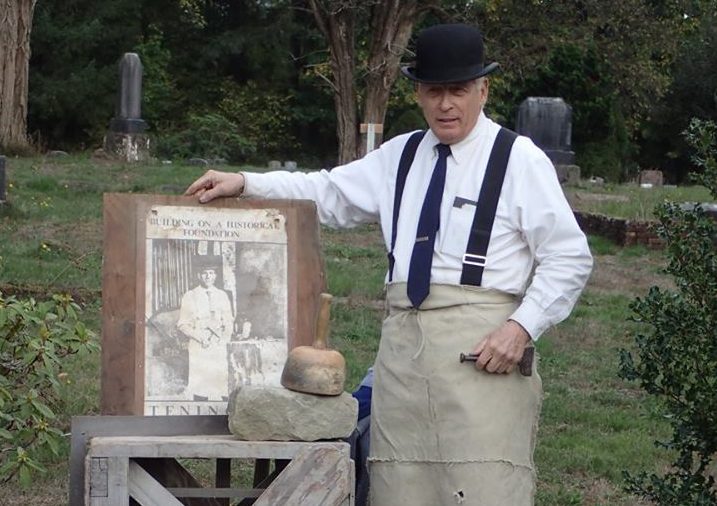It is a cold and clear sunny day at what was once known as the Hercules Sandstone Quarry in Tenino, Washington. Keith Phillips, stone cutter, is cleaning up after his latest carving – a mysterious and beautiful, Aztec-feathered serpent, called a Quetzalcoatl – was picked up by a client.
 A gray sheen of dust lies everywhere in the work shed nestled at the base of the old quarry as great chunks of ice fall from the quarry heights in the noonday sun. Keith admits it’s not a bad place to work. Here, he is immersed in the history of what was once a bustling quarry and workplace, now quiet except for himself and his apprentice, Ed Salerno. But, he is also surrounded by potential and creativity as the old mine is ringed by enough massive, loose stones to carve for the rest of his career.
A gray sheen of dust lies everywhere in the work shed nestled at the base of the old quarry as great chunks of ice fall from the quarry heights in the noonday sun. Keith admits it’s not a bad place to work. Here, he is immersed in the history of what was once a bustling quarry and workplace, now quiet except for himself and his apprentice, Ed Salerno. But, he is also surrounded by potential and creativity as the old mine is ringed by enough massive, loose stones to carve for the rest of his career.
A Master in the Making
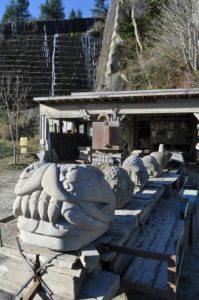
Living history is of great interest to Keith. He enjoys doing things the old fashioned way. “I don’t have a lot of modern machinery,” Keith explains. “I work on the idea that if you can move a stone an inch you can move it a mile.”
In fact, researching the way things used to be done is how Keith got his start in stone carving. After Keith graduated from college, he wasn’t sure what he wanted to do and considered a career as a farmer. While studying agriculture, he picked up a book about farming in Great Britain containing a picture of a merestone. This is a block erected to mark the corner of someone’s property. Keith decided to make one for his dad’s birthday. He consulted Tenino locals Walt and Larry Scheel, and after a few pointers he went back to Ellensburg and got to work. Keith went on to make several of these.
“I thought, ‘I can do this. I can carve stone,’” reminisces Keith. “This was about 1988, and Tenino was experiencing its stone renaissance. I came to Tenino and walked into a situation made in heaven.”
Soon word got out, and he created a mortar and pestle carving for Heddens’ Pharmacy, a giant bag of groceries for what is now an IGA, and the centennial cross for the First Presbyterian Church of Tenino. In fact, walking around Tenino, one can find Keith’s work almost everywhere.
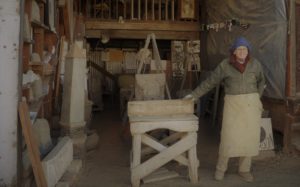
Photo credit: Jessica Reeves-Rush
Keith explains the initial phases of his new trade. “When I first started, I wanted to be a stone carver. I wanted to carve leaves and birds and lettering, and that’s all I wanted to do. But before too long I realized I had to carve this stone to fit into the wall at Tenino Parkside Elementary School. I had to cut it to dimension, look at blue prints and fit it into the wall. And after that, there was just a series of jobs that required I know about geometry, triangles, hexagons and pentagons.”
As a result, Keith started working on a portfolio to sell his talent for restoration work in Tacoma and Seattle which required the knowledge to square up stones to blue prints. In the 90’s this was good business. Keith had become a modern-day stone cutter. When supplying to specification, he had to make everything fit in dimension.
Soon after, Keith got a job restoring the lantern of the Washington State Capitol Building after the Nisqually earthquake. The owner of the Tenino quarry had connections in Portland where Keith was then commissioned to do a bit of work. When Keith became the night watchmen of the quarry, he parked his trailer on site and worked nearly day and night. As he puts it, he’s “been off to the races ever since.”
A History of Stone Cutting
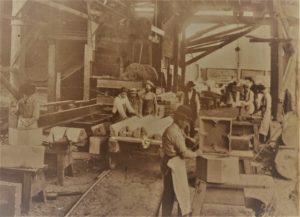
Carvings and monuments etched in stone, lasting for hundreds of years, are romantic and sometimes whimsical, but their creation is born in precision. Keith wasn’t about to become a stone carver without learning the history of how it used to be done.
“As a novice you were tested by the old guys in the shop to see if you were up to snuff,” explains Keith. “If they thought you had it in you, they gave you a rough stone to square up into a cube. If you passed the test of doing the cube, you might be put on the job to level out a surface of rough stone to make it flat. Then, you would be asked to make the sides square with that one plane and just practice the use of the tools and geometry or more specifically stereotomy. They might have you carve a leaf between jobs to test your mettle. Then, they might have you do a rock face like the one on the new bank in Tenino. Next, you’d be asked to carve on this surface some lettering. That might be your first job.”
A stone cutter was historically more important than a decorative carver. The stones served as the foundations and building structure of enormous buildings, cathedrals even, and the profession was one that demanded respect.
“After the industrial revolution came, those men really didn’t have to hand chisel those squares and rectangles any more,” says Keith. With the rise of machinery, stone cutters became nearly obsolete by the late 1800s and the same holds true event today with few of these artisans left.
Looking to the Future
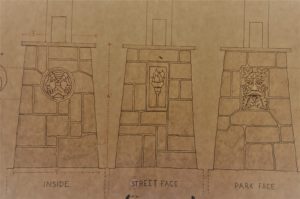
Keith looks to preserve the history of his profession and pass along his knowledge. “I am always looking for someone to take over the operation because I’m 70 and the city of Tenino is concerned about that. Is there going to be someone after me? Well, they are pretty happy about Ed.”
Ed Salerno has been apprenticing with Keith for a couple years now. Like Keith, Ed was wondering what direction his life would take when one fateful day he rode his bike through Tenino and visited the Tenino Depot Museum. The museum sent him out to meet Keith. Now, Ed is a carver in his own right, creating birds and letters, flowers and more.
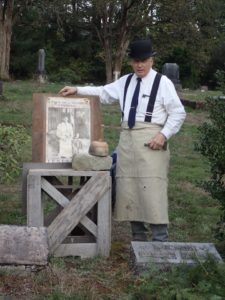
One of Keith and Ed’s current projects involves the entrance to the Tenino City Park. They have cut piles of rectangles and squares to veneer the two pillars for the entrance. Ed did the rendering for the new pillars which will feature a Greenman, a torch and a Janus stone.
Keith would like to see Tenino become a hub for craftspeople and folks who like to do things the old way, like a blacksmith and a potter. One new artisan is located just down the road at A. G. Piano where they make violins by hand as well as repair pianos.








































